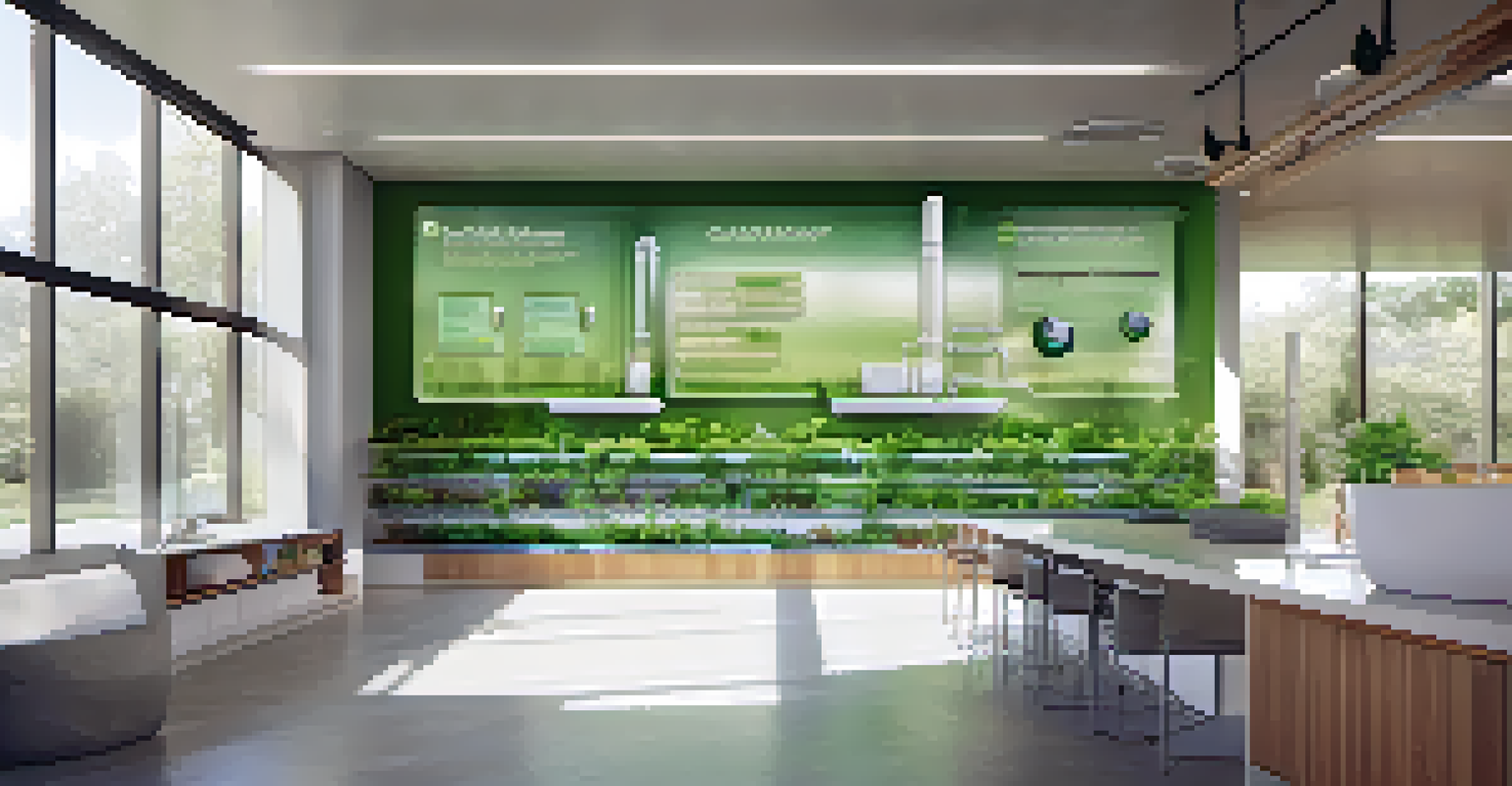Water Conservation Strategies in NYC's Green Buildings

Understanding the Importance of Water Conservation
Water conservation is crucial, especially in urban areas like New York City, where resources are strained. With millions of residents, the demand for water continues to rise, making sustainable practices essential. Green buildings play a pivotal role in reducing water waste and promoting efficient usage.
We forget that the water cycle and the life cycle are one.
By implementing water-saving technologies and practices, these buildings can significantly lower their environmental impact. This not only benefits the ecosystem but also helps in reducing utility costs for residents and businesses alike. In a city where every drop counts, this focus on conservation is more vital than ever.
Moreover, the push for water conservation aligns with broader sustainability goals, making cities more resilient against climate change. As NYC continues to grow, these strategies are not just beneficial but necessary for the future health of the city.
Rainwater Harvesting: A Smart Solution
Rainwater harvesting involves collecting and storing rainwater for reuse, which is a smart strategy for New York's green buildings. By capturing water that would otherwise run off rooftops, buildings can reduce their reliance on municipal water supplies. This method not only conserves water but also helps manage stormwater runoff, reducing flooding risks.

Implementing rainwater systems is becoming increasingly popular among new developments and retrofits in NYC. These systems can be used for irrigation, toilet flushing, and even cooling systems, showcasing their versatility. Additionally, they contribute to the overall sustainability of the building, making them a favorite among eco-conscious developers.
Water Conservation is Essential
With increasing demand in urban areas like NYC, sustainable water practices are crucial for reducing environmental impact.
As awareness of water scarcity grows, more developers are recognizing the benefits of rainwater harvesting. This practice not only enhances a building's green credentials but also provides a practical solution to urban water management challenges.
Greywater Recycling: Reusing What We Have
Greywater recycling involves the reuse of water from sinks, showers, and laundry for non-potable purposes, making it an effective conservation strategy. In NYC's green buildings, this can significantly reduce the amount of freshwater needed for irrigation and toilet flushing. By treating and redirecting greywater, buildings can minimize their overall water consumption.
Conservation is a state of harmony between men and land.
Many modern green buildings are equipped with greywater systems that filter and treat this water, making it safe for specific uses. This not only conserves water but also helps in managing wastewater effectively. The implementation of these systems is becoming a hallmark of sustainable design in urban environments.
As NYC continues to adapt to climate change, greywater recycling serves as a practical solution to mitigate water scarcity. It's a win-win situation, as it reduces the demand for freshwater while promoting responsible water management practices.
Water-Efficient Landscaping Design
Water-efficient landscaping is another key strategy employed in NYC's green buildings. By utilizing native plants and xeriscaping techniques, these landscapes require less water and are more resilient to local climate conditions. This approach not only conserves water but also supports local biodiversity.
Incorporating features like rain gardens and permeable pavements can further enhance water conservation in these green spaces. Such designs allow rainwater to filter into the ground rather than running off, thus replenishing groundwater supplies. This is especially important in urban areas where natural water absorption is limited.
Innovative Water Management Solutions
Technologies such as rainwater harvesting and greywater recycling are effective strategies for conserving water in green buildings.
As more developers prioritize sustainable landscaping, the aesthetic and environmental benefits of water-efficient designs become increasingly clear. This not only beautifies the urban environment but also fosters a sense of community and connection to nature.
Smart Water Management Technologies
The integration of smart water management technologies is revolutionizing water conservation in NYC's green buildings. These systems utilize sensors and data analytics to monitor water usage in real-time, identifying leaks and inefficiencies quickly. By providing valuable insights, building managers can make informed decisions to optimize water use.
For instance, smart irrigation systems can adjust watering schedules based on weather conditions, ensuring that landscapes receive the right amount of water without waste. Additionally, these technologies can automate water-saving features in plumbing fixtures, further enhancing conservation efforts.
As technology continues to advance, the potential for innovative solutions to water conservation only grows. Embracing these smart technologies not only benefits individual buildings but also contributes to the city's overall sustainability goals.
Behavioral Change: Engaging Building Occupants
While technology plays a significant role, engaging building occupants is crucial for effective water conservation. Educating residents about the importance of water-saving practices can foster a culture of sustainability within the building. Simple actions, like turning off taps while brushing teeth or reporting leaks, can collectively make a big difference.
Many green buildings in NYC implement awareness campaigns and workshops to encourage responsible water usage. By involving residents in conservation efforts, these initiatives create a sense of community and shared responsibility. This engagement ensures that water-saving technologies are utilized effectively.
Community Engagement Matters
Educating building occupants and fostering a culture of sustainability can significantly enhance water conservation efforts.
Ultimately, changing behaviors and attitudes towards water usage is just as important as installing advanced systems. When occupants feel invested in their building's sustainability, they are more likely to adopt water-conscious habits.
Regulations and Incentives for Water Conservation
Government regulations and incentives play a vital role in promoting water conservation in NYC's green buildings. Initiatives like the NYC Department of Environmental Protection’s water conservation programs provide resources and funding for sustainable practices. These incentives encourage developers to adopt water-efficient technologies and design features.
Moreover, local laws often require new developments to meet specific sustainability standards, which include water conservation measures. Such regulations ensure that water-saving strategies are not just optional but integral to building design. This creates a framework that supports the growth of green buildings in the city.

As regulations evolve, they often reflect the growing awareness of water scarcity issues. This proactive approach not only benefits the environment but also positions NYC as a leader in sustainable urban development.
The Future of Water Conservation in NYC's Green Buildings
Looking ahead, the future of water conservation in NYC’s green buildings is promising, with ongoing innovations and strategies emerging. As climate challenges intensify, the need for efficient water management will only increase. Developers and city planners are collaborating to create resilient designs that prioritize both sustainability and functionality.
Emerging technologies, such as advanced water purification systems and smart monitoring tools, will continue to enhance conservation efforts. Additionally, public awareness and engagement will be key in driving the adoption of these practices across the city. The community's commitment to sustainability can lead to lasting change.
Ultimately, the integration of these strategies not only addresses water scarcity but also sets a precedent for other urban areas around the world. NYC serves as a model for how cities can innovate and adapt to ensure that water conservation remains a priority for future generations.